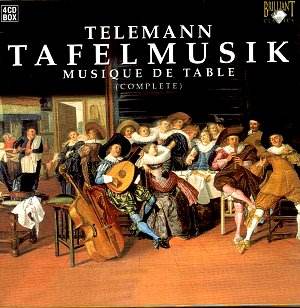Musique de Table, Production I
Ouverture - Suite in E minor for two
flutes, strings
Quatuor in G major for flute, oboe,
violin
Concerto in A major for flute, violin,
violoncello, strings
Trio in E-flat major for two violins
Solo in B minor for flute
Conclusion in E minor for two flutes,
strings
Musique de Table, Production II
Ouverture-Suite in D major for oboe,
trumpet, strings
Quatuor in D minor for recorder, two
flutes
Concerto in F major for three violins,
violino grosso
Trio in E minor for flute, oboe
Solo in A major for violin
Conclusion in D major for oboe, trumpet,
strings
Musique de Table, Production III
Ouverture-Suite in B flat major for
2 oboes, bassoon, strings
Quatuor in E minor for flute, violin,
violoncello
Concerto in E flat major for two horns,
strings
Trio in D major for 2 flutes
Solo in G minor for oboe
Conclusion in B flat major for two oboes,
bassoon, strings
The three so-called
Productions of the Tafelmusik or Musique
de Table fit nicely onto four CDs and
that’s what we have here. The Productions
all have their individual colours and
ensemble highlights; No.1 for instance
is dominated by the flute, No.2 by the
oboe and trumpet and each separate Production
(Telemann’s own word) is laid out on
an established ground plan that takes
in an Overture-Suite, Quartet, Concerto,
Trio, Solo and a Conclusion (usually
a short and pithy summary). The Tafelmusik
was issued on subscription in 1733 (celebrity
subscribers included a certain "M.
Haendel de Londres" as well as
Quantz and Pisendel amongst others –
you’ll notice the similarity between
certain parts of the Sonata (Production
1) and the Suite (Production 2) and
Handel’s own Organ Concertos amongst
other borrowings.)
So there is plenty
of variety and colour and moments too
of reflective intimacy amidst the grand
schema of Telemann’s design. Musica
Amphion under Pieter-Jan Belder are
bright, subtle and idiomatic guides
to the repertoire. I liked their sense
of flexibility without precious over-accentuation,
liked, too, the way that the continuo
part is rightly subservient in the Overture-Suite
(Production No 1). Here the violin-flute
exchanges are finely judged; articulation
is good, as is the tempo with a basso
continuo nicely shaped. Musica Amphion
can fine down their sound well – the
single voiced lines of the sixth movement
Air are expert indeed. The principals
are refreshingly straightforward – listen
to the noble and forthright oboe of
Frank de Bruine in the second movement
of the Quartet, the flexible and lyrical
cello of Jaap ter Linden or the infectious
drive cultivated in the Concerto – where
the little pizzicato episodes are handled
with discretion and apt delicacy. The
Trio’s Affettuoso opening sounds very
much like Handel’s Violin Sonatas Op.
1 but by the time of the Allegro finale
Telemann’s frolicsome individuality
is quite apparent (the likelihood that
the influence was the other way around,
in any case). Flautist Wilbert Hazelzet
shows fine breath control in the Solo
in B minor – and his colleagues make
this a standout performance from the
First Production.
Their approach to the
opening Overture-Suite of Production
II is just as satisfying. Whilst some
other groups may cultivate greater reserves
of colour or style Musica Amphion impresses
through their balanced approach – it’s
bracing and buoyant and very musically
satisfying. Thus the chording in the
Quartet is brisk and the subsequent
melodic episodes full of lilting informality
and whilst the Allegro from the Concerto
will remind you of Bach the Largo conveys
gravity at a tempo giusto without any
expressive highlighting along the way.
In the Trio the group makes a clear
expressive difference between the markings
Affettuoso and Dolce and in the same
work’s finale the cuckooing vibrancy
and finesse is well conveyed. Danny
Bond’s bassoon impresses in the Overture-Suite
of No.3 – incision, rhythm and good
tone - and when we arrive at the fine
Quartet in this Production we encounter
another good quality of these performances,
a fine sense of ensemble balance, as
well as cultivation of anticipation
and tension. The Concerto sports noble
maestoso horns and there is crisp articulation
in the Trio, a sprightly command of
the Solo (for oboe) when it’s not cultivating
a galant profile instead or indulging
some glorious suspensions in the Andante.
Telemann keeps his most arresting Conclusion
for the last; a real hum dinger marked
Furioso and lasting not quite two minutes.
I enjoyed the concertante
aspects of these performances greatly;
phrasing is unmannered and straightforward
without becoming prosaic and they evince
a true chamber intimacy in the Trios
and Quartets. Characterisation of the
various movements, whether Francophile
or Vivaldian is acutely judged and the
rewards are uniform – and lasting.
Jonathan Woolf


